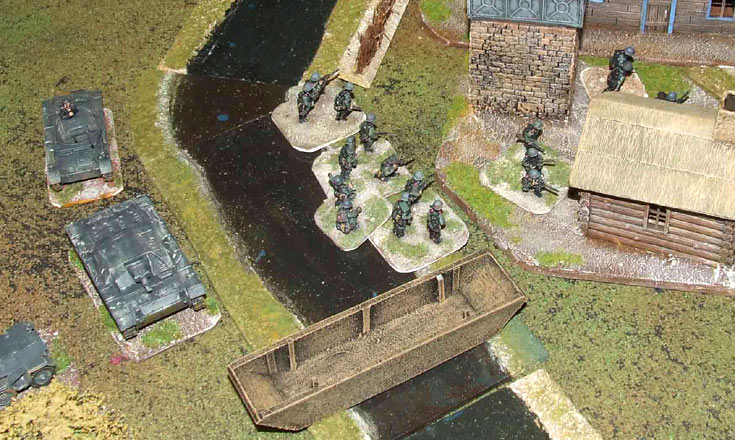
Crossing the Velikaya, 1941
12th March 2009, Comments Off
The Second World War, Battlegroup Panzergrenadier, 20mm
This week we adapted a Charles S. Grant scenario – “Assault River Crossing” – culled from Scenarios for Wargames, 1981. We set our game in the summer of 1941, somewhere to the north of Polotsk. The Germans of the 4th Panzer Group needed to establish a bridgehead across the river, having failed to capture the bridges at Idritsa, further downstream. Blue force (the Russians) held the east bank, by garrisoning the two hamlets marked “X” and “Y”. A mobile reserve is held off the table, and is available as reinforcements. As for Red force (the Germans), they begin anywhere along line “A-B-C”, and it takes a turn to rush their assault boats to the water’s edge. Red force wins the game if they establish a viable bridgehead on the eastern bank.
Blue force (the Russians) held the east bank, by garrisoning the two hamlets marked “X” and “Y”. A mobile reserve is held off the table, and is available as reinforcements. As for Red force (the Germans), they begin anywhere along line “A-B-C”, and it takes a turn to rush their assault boats to the water’s edge. Red force wins the game if they establish a viable bridgehead on the eastern bank. In fact, the Germans launched their assault from point “C”, covered by anti-tank guns and other heavy weapons deployed to fire into the flank of any Russian reinforcements. The initial assault was costly – Russian artillery zeroes in on the pontoons, and casualties were heavy. The defenders in hamlet “X” were also pounded by artillery, and soon only the command stand remained.
In fact, the Germans launched their assault from point “C”, covered by anti-tank guns and other heavy weapons deployed to fire into the flank of any Russian reinforcements. The initial assault was costly – Russian artillery zeroes in on the pontoons, and casualties were heavy. The defenders in hamlet “X” were also pounded by artillery, and soon only the command stand remained. However, like a true hero of the Soviet Union he repulsed the first German attack (by rolling a timely double “6”), then went on to eject the German assault engineers, armed with flamethrowers. Sensibly enough he then cut his losses and headed for the nearest friendly cover.
However, like a true hero of the Soviet Union he repulsed the first German attack (by rolling a timely double “6”), then went on to eject the German assault engineers, armed with flamethrowers. Sensibly enough he then cut his losses and headed for the nearest friendly cover. The Germans now had their bridgehead, and the onus was now on the Russians to eject them. The first batch of reinforcements arrived – infantry supported by T-34’s, which managed to suppress the German armour deployed to protect the right flank of the bridgehead. Unfortunately they lacked the strength to assault hamlet “X”.
The Germans now had their bridgehead, and the onus was now on the Russians to eject them. The first batch of reinforcements arrived – infantry supported by T-34’s, which managed to suppress the German armour deployed to protect the right flank of the bridgehead. Unfortunately they lacked the strength to assault hamlet “X”. On the other flank another group of infantry were hammered as they attacked across the open steppe, while the supporting T-26’s were halted by German “door-knocker” anti-tank guns, firing from the southern side of the river.
On the other flank another group of infantry were hammered as they attacked across the open steppe, while the supporting T-26’s were halted by German “door-knocker” anti-tank guns, firing from the southern side of the river. The game ended when the Russian players admitted defeat – the German bridgehead was too well-defended. Still, it was a thoroughly enjoyable and hard-fought game. Like most of Charles’ scenarios, it was also finely balanced, and victory could easily have gone to either side. His original scenario was designed for a “horse and musket” game, but it worked just as well when the horses were swapped for T-34’s and the muskets replaced by MG-34’s.
The game ended when the Russian players admitted defeat – the German bridgehead was too well-defended. Still, it was a thoroughly enjoyable and hard-fought game. Like most of Charles’ scenarios, it was also finely balanced, and victory could easily have gone to either side. His original scenario was designed for a “horse and musket” game, but it worked just as well when the horses were swapped for T-34’s and the muskets replaced by MG-34’s.

